What Ending U.S. Assistance Means for the Caucasus and Central Asia
Recent Articles
Author: Nigel Li, Joshua Bernard-Pearl, Nicholas Castillo
02/10/2025
With the current U.S. administration shuttering the United States Agency for International Development (USAID), the countries of the Caspian region face the prospect of the disappearance of funds for economic and political development. The primary stated objective of U.S. Government (USG) foreign assistance is to promote U.S. and international security and prosperity by bolstering economic and political stability and self-reliance in developing countries. A broad consensus in the U.S. Congress has traditionally supported USAID investments in global development progress as being vital to U.S. national security. In Central Asia and the South Caucasus, USAID has provided assistance through eight regional Missions and Offices covering a wide range of programs.
As almost two-thirds of the growth in U.S. goods exports in the last decade was due to major USAID partners, and strong export growth was critical to pulling the United States out of the recent recession, USAID programs in Trans-Caspian countries focused particularly on supporting economic growth and self-reliance. The U.S. Congress approved and authorized funds for the Washington-based development agency to help create better, stronger, and more resilient markets globally for U.S. exports.
Founded in 1961, USAID has been a fixture in the South Caucasus and Central Asia since the collapse of the Soviet Union. In 2023 alone, the U.S. Congress approved $340 million in obligations for USAID programs in the region ($154 million in Central Asia and $185 million in the South Caucasus), working in partnership with host countries on issues ranging from free market development to anti-HIV/AIDS programming. The absence of these programs will likely create openings for the region’s neighbors and other development efforts to fill the U.S. void.
Armenia
In fiscal year 2023, USAID earmarked a total of $71.68 million in obligations to Armenia. The top sector by far receiving USAID funding was Democracy, Human Rights, and Governance ($40.87 million) followed by Economic Development ($15.64 million), Humanitarian Assistance ($3.2 million), Peace and Security ($2.575 million), and Education and Social Services ($1.512 million). USAID support has largely revolved around the goals of facilitating Armenia's transition to a free-market, democratic society with long-term sustainable development.
To enhance inclusive growth, USAID programs seek to develop new and sustainable value chains, create jobs, and increase access to markets and finance, enabling Armenians to stay in their communities and reducing migration and dependence on remittances. Activities that promote agriculture, agribusiness, and cultural and natural tourism serve to promote rural economic opportunities across the country, including in some of the most marginalized areas. Among projects in other sectors, USAID also supports the inter-linked energy and water sectors, which are critical to Armenia’s economic security and independence.
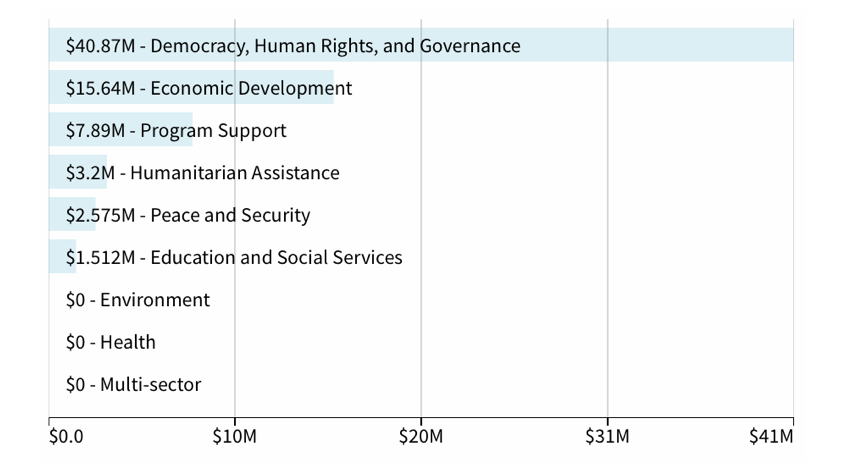
Azerbaijan
In fiscal year 2023, USAID designated a total of $21.92 million in obligations to Azerbaijan. The primary sectors receiving USAID funding were Basic Health ($4.5 million), Government and Civil Society ($4.2 million), followed by Business and Other Services ($3.5 million) and Basic Education ($2 million). In the health sector, USAID support in Azerbaijan has been centered around working with the Ministry of Health to improve healthcare in three important areas: (1) tuberculosis infection control; (2) maternal, neonatal, and child health (MNCH); and (3) women and children’s nutrition. USAID economic growth programs to improve the investment climate directly support these goals of economic diversification, particularly in agriculture, as well as expand Azerbaijan’s economic partners and advance its integration with European markets.
The Government of Azerbaijan’s Vision 2020 Plan promotes a highly competitive economy and the development of the non-oil sector. USAID economic growth efforts programmed to improve the investment climate directly support these goals of economic diversification, particularly in agriculture, as well as expand Azerbaijan’s economic partners and advance its integration with European markets. To support a more resilient Azerbaijan economy and improve the business-enabling environment, USAID has enhanced the capacity of commercial banks to provide sustainable market-based financial intermediation services to small and medium enterprises so that entrepreneurs can expand their businesses.
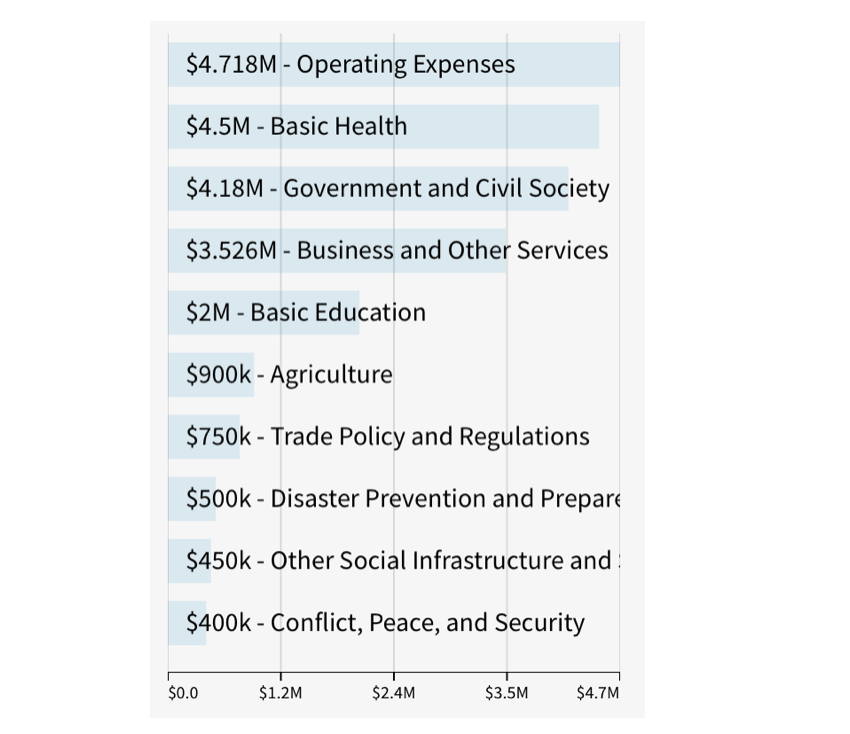
Georgia
In fiscal year 2023, USAID earmarked a total of $91.37 million in obligations to Georgia. The top sectors receiving USAID funding were Economic Development ($35.4 million); Democracy, Human Rights, and Governance ($32.54 million); followed by Peace and Security ($5.399 million) and Education and Social Services ($3.3 million). USAID support in Georgia has focused on economic development, especially around energy infrastructure, and supporting Georgia’s “democratic, free-market, Western orientation” through good governance and human rights initiatives. The largest project in Georgia, titled Promoting Rule of Law in Georgia (PROLoG), focuses on strengthening Georgia's justice system to ensure due process, judicial independence, and the protection of human rights.
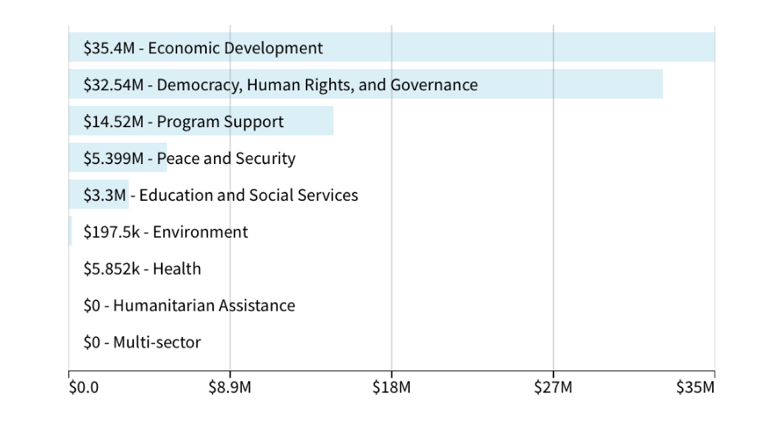
Kazakhstan
In Kazakhstan, USAID advances the U.S. Government’s Central Asia Strategy that supports and strengthens the sovereignty and independence of Central Asian countries, individually and as a group; encourages regional connectivity between Central Asia and Afghanistan, promotes rule of law and respect for human rights, and improves the climate for U.S. investment. All of this is to foster greater regional stability and prosperity.
In fiscal year 2023, USAID earmarked a total of $12.41 million in obligations to Kazakhstan. The top sectors that received USAID funding were in basic health ($5.94 million), government and civil society ($4.05 million), HIV/AIDs prevention ($1.326 million), and energy ($500,000). USAID has prioritized combatting infectious diseases, fostering inclusive governance institutions, diversifying trade, and promoting regional cooperation in energy and water resources.
USAID worked with Kazakhstan’s National Tuberculosis Program and in the past eight years saw a 50% decrease in new TB cases. In combatting the spread of HIV, USAID has supported initiatives for increased testing and for adopting policies to support people living with HIV such as access to antiretroviral therapy.
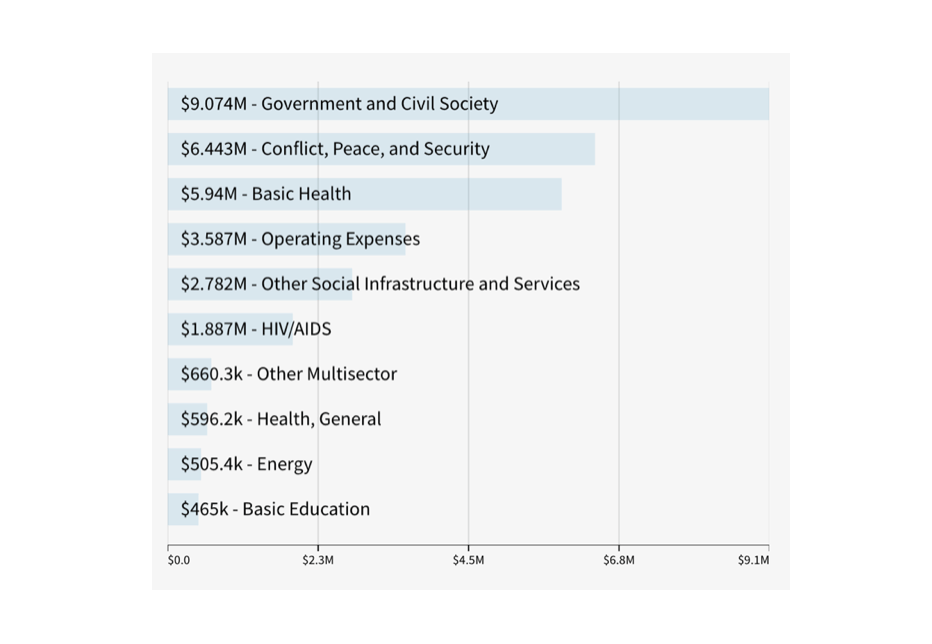
Kyrgyzstan
In fiscal year 2023, USAID had a total of $42.17 million in obligations to Kyrgyzstan. The top sectors that received USAID funding were in government and civil society ($12.24 million), basic health ($11.17 million), business and services ($7.1 million), education ($3.7 million), and HIV/AIDS prevention ($1.79 million).
The limited economic opportunities in the Kyrgyz Republic contribute to a phenomenon of mass labor migration: approximately one million people, out of a total population of six million, work abroad. The money labor migrants send back home to support their families amounts to one-third of the country’s GDP - one of the highest rates in the world. USAID supports job creation and economic growth in the Kyrgyz Republic with a focus on the poorest regions. This contributes to reducing labor migration, keeps families together, and helps them build better lives.
In partnership with civil society and the private sector, USAID supports the government’s commitment to accelerate economic growth, especially in marginalized and rural areas. Supporting the improvement of the overall business environment by working together with the government, USAID seeks to promote trade and investment, particularly from European and American companies, while facilitating Kyrgyzstan’s access to domestic and foreign markets.
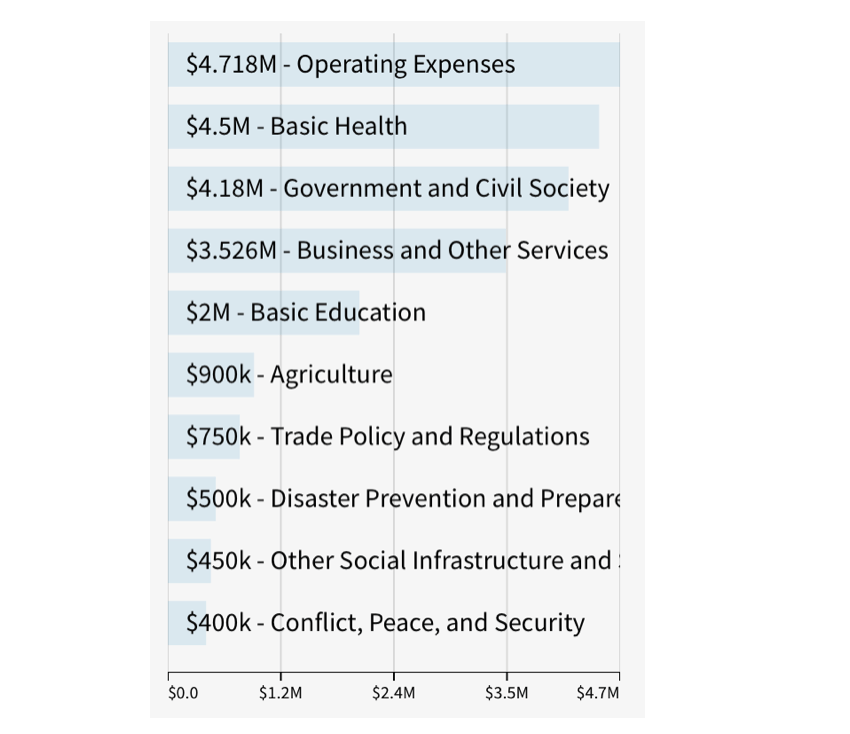
Tajikistan
Tajikistan is the poorest member of the Commonwealth of Independent States, with nearly 20 percent of the population living on less than $1.90 a day, while 56.6 percent lives on less than $3.10 a day. The country remains highly susceptible to external economic shocks and has suffered from recent regional economic downturns triggered by Russia’s economic crisis, resulting in a 54 percent decrease in remittances from migrant laborers working abroad.
The agricultural sector has been a focus of U.S. assistance in Tajikistan, offering a solid foundation for economic development and reduced dependence on foreign assistance. In addition to supporting agriculture and agribusiness through Feed the Future, USAID supports the Tajikistan government’s goal to move toward an agro-industrial economy through an increased focus on expanding the private sector within the agriculture and transit and logistics sectors to improve regional and international connectivity.
USAID in fiscal year 2023 had a total of $60 million set aside in obligations for Tajikistan, putting the country on the higher end of recipients in the Caspian region. The largest sector for the country was $18.9 million in agriculture development, followed by $15.3 million in health spending, $4.65 million in basic education, $4.6 million in operating expenses, $3 million in government and civil society promotion, $2.7 million relating to business promotion, and the rest going to variety of other programs.
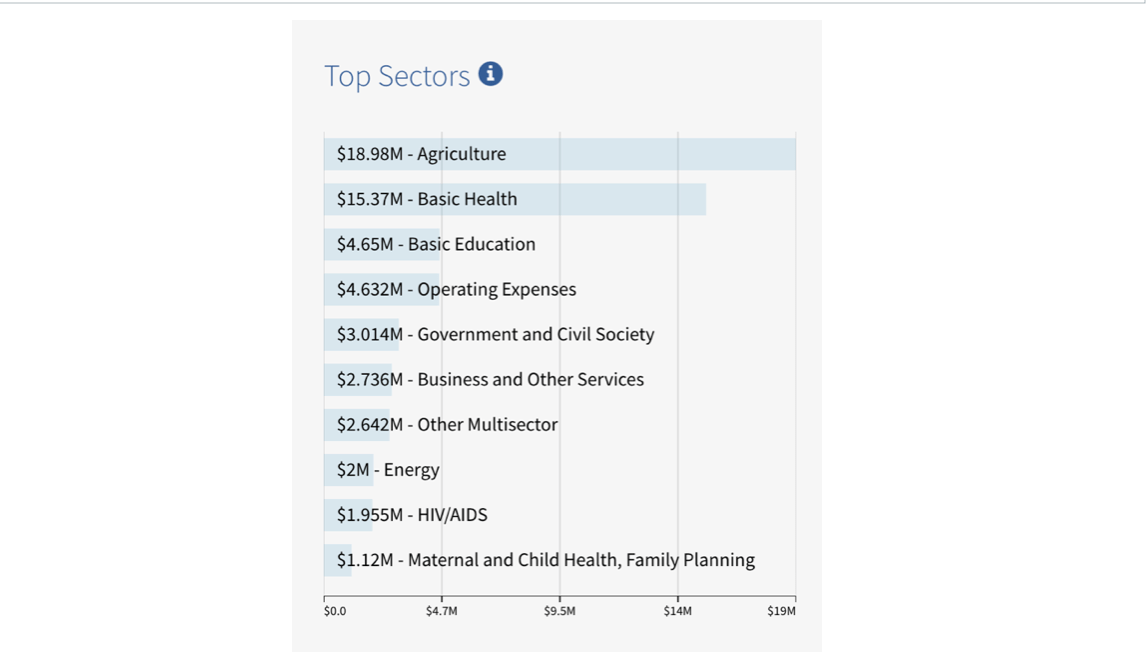
The largest single program is the “Feed the Future Tajikistan Agriculture and Land Governance” initiative, costing $7.6 million, aiming to help develop small-scale and private-sector Tajik farms and agricultural firms leading to a more sustainable agricultural market. According to USAID, the program has “produced more than 1.5 million seedlings of improved tomato, cucumber, and sweet pepper varieties, which in turn produced more than 20,000 metric tons of nutritious produce.”
Turkmenistan
In fiscal year 2023, USAID had a total of $2.7 million in obligations to Turkmenistan. Of this total, $1.3 million was directed toward democracy, government support ,and civil society; $920,000 was directed toward economic development; and a final $491,000 was set aside for program support. The most expensive USAID programs run in Turkmenistan were two that both had budgets of $600,000, the first aiming at good governance support and the second providing thousands of Turkmen youths with skills useful in developing free-market enterprises. Other USAID programs include work combatting human trafficking and implementing e-governance.
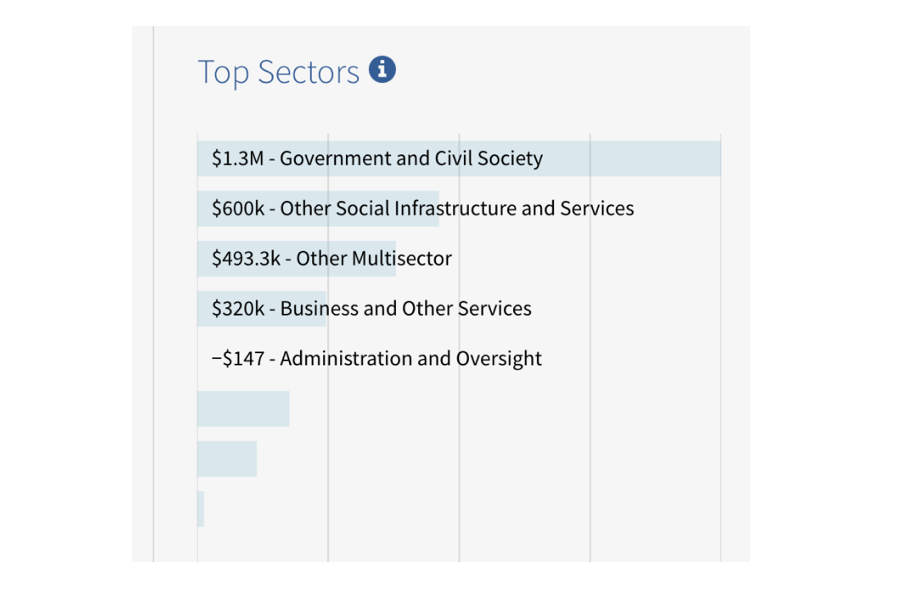
Uzbekistan
Uzbekistan saw $37 million in obligations from USAID in 2023. The largest chunk of this sum, $9.3 million, went toward health services, followed by civil society and governance support at $8.5 million, program costs at $5.2 million, $5.2 million for upper-secondary education, $3.2 million in work relating to trade policy and regulations, $2 million for business development, and $1.3 million for basic education, and the remainder for miscellaneous programs.
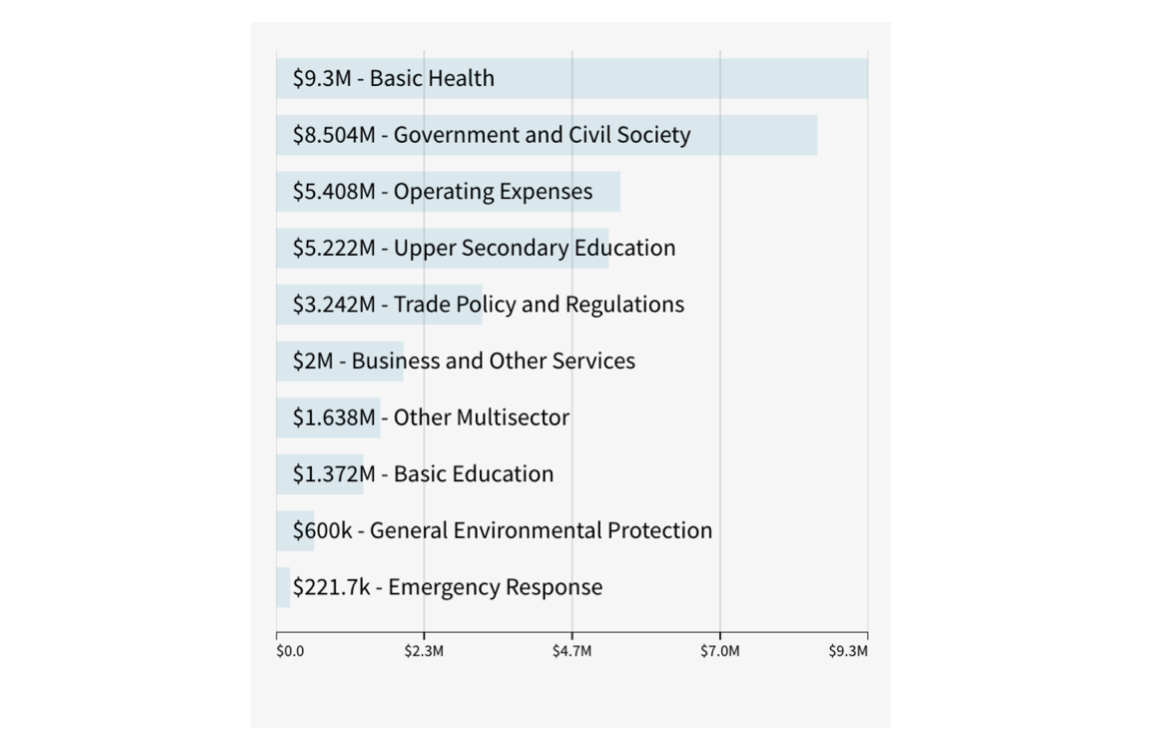 USAID supported hundreds of microenterprises in Uzbekistan, working throughout the horticulture value chain, primarily on the farm/production level to reduce labor migration, improve nutrition, and boost the region’s small-holding farms. USAID continues to assist Uzbekistan with diversifying export markets. Over the last four years, USAID has incentivized horticultural producers and processors to adopt new technologies and practices. USAID leveraged over $10 million in 2019 for private-sector investment in the establishment of new orchards, installation of water-saving technologies, increase in cold-chain capacity countrywide, and upgrades in product packaging, marketing, and branding to meet international standards.
USAID supported hundreds of microenterprises in Uzbekistan, working throughout the horticulture value chain, primarily on the farm/production level to reduce labor migration, improve nutrition, and boost the region’s small-holding farms. USAID continues to assist Uzbekistan with diversifying export markets. Over the last four years, USAID has incentivized horticultural producers and processors to adopt new technologies and practices. USAID leveraged over $10 million in 2019 for private-sector investment in the establishment of new orchards, installation of water-saving technologies, increase in cold-chain capacity countrywide, and upgrades in product packaging, marketing, and branding to meet international standards.
The most expensive health program managed by USAID was a $3.1 million anti-tuberculosis program that sought to reach 2027 national/United Nations High Level Meeting (UNHML) tuberculosis targets through “optimized reach, cure, prevention, and sustained technical area interventions that will expand high-quality, people-centered, affordable, and integrated TB-related health activities with robust national and sub-national health systems.”